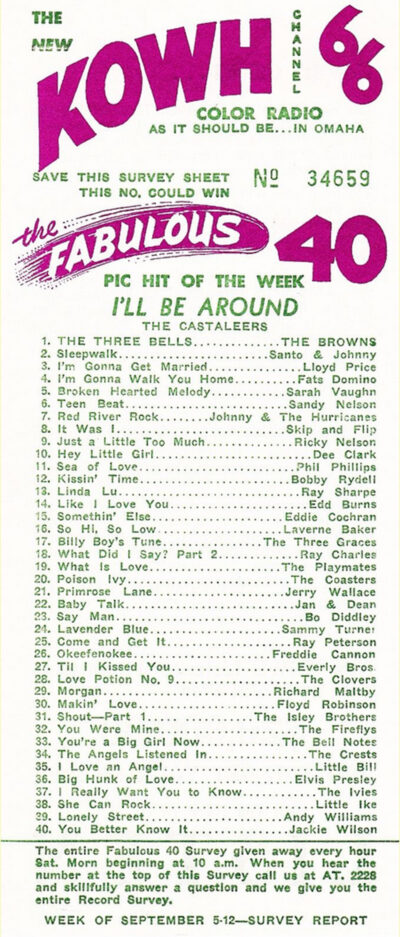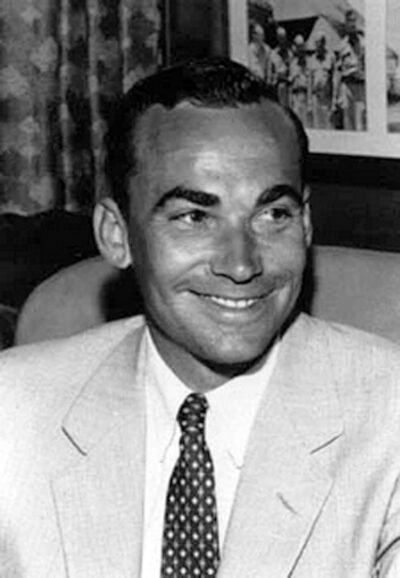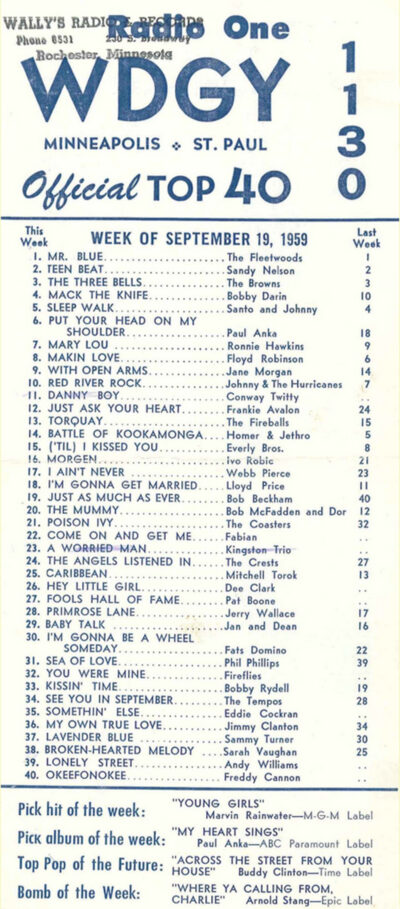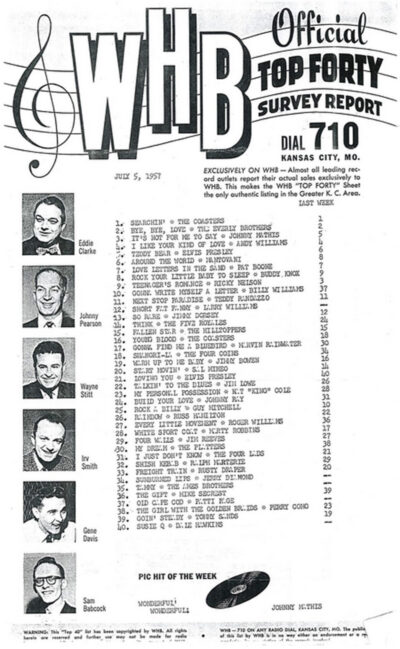Introduction: The Pulse of a New Radio Sound, Re-Imagined Long before algorithms curated our playlists and countdowns ruled the airwaves, there was
Introduction: The Pulse of a New Radio Sound, Re-Imagined
 Long before algorithms curated our playlists and countdowns ruled the airwaves, there was a young man in Omaha who simply listened. Not to consultants or ratings reports—but to the rhythm of everyday life. In the clatter of diner jukeboxes, in the laughter of teenagers feeding nickels into machines, Todd Storz heard something extraordinary: a pattern, a pulse, a longing.
Long before algorithms curated our playlists and countdowns ruled the airwaves, there was a young man in Omaha who simply listened. Not to consultants or ratings reports—but to the rhythm of everyday life. In the clatter of diner jukeboxes, in the laughter of teenagers feeding nickels into machines, Todd Storz heard something extraordinary: a pattern, a pulse, a longing.
The same songs played again and again—not out of habit, but out of love. And in that repetition, he found revelation.
Todd Storz didn’t invent music. He didn’t write the hits or sing the hooks. But he understood something that would change radio forever: the emotional gravity of popular sound. At a time when stations scattered their programming across genres and formats, Storz dared to believe that listeners knew best. What moved them—what they danced to, cried to, fell in love to—deserved to be heard not once, but often. And so, the Top 40 was born.
This is the story of a man who turned jukebox choices into a broadcasting blueprint. Who saw music not as filler between news breaks, but as the heartbeat of a generation. From a modest station in Omaha to a coast-to-coast empire of sound, Todd Storz reshaped the radio dial—and in doing so, gave voice to the desires of millions.
His legacy isn’t just measured in playlists or ratings. It lives in every countdown show, every hit replayed, every moment when a song feels like it was chosen just for you.
This tribute honors the man who made radio personal, rhythmic, and unforgettable.– USA Radio Museum
_____________________
KOWH Omaha — Where the Revolution Took Root
In the early 1950s, Omaha wasn’t exactly the epicenter of broadcasting innovation. But tucked inside a modest building on the city’s south side, something extraordinary was happening. KOWH-AM, a station owned by Robert Storz and his son Todd, was quietly rewriting the rules of radio—one record at a time.
Todd Storz was just in his twenties when he began experimenting with programming at KOWH. He wasn’t guided by industry norms or academic theory. Instead, he relied on instinct, observation, and a deep curiosity about what made people listen. One of his most famous insights came not from a boardroom, but from a bar. As the story goes, Todd watched patrons repeatedly play the same songs on a jukebox—hits like “Come On-a My House” and “Cry.” The repetition wasn’t mindless; it was emotional. People wanted to hear what they loved, again and again.
That simple realization became the cornerstone of a radical idea: what if radio mirrored the jukebox? What if stations played the most popular songs more frequently, creating a rhythm that matched the public’s taste rather than dictating it?
At KOWH, Todd put the theory into practice. He tightened the playlist, focused on chart-topping records, and introduced a programming style that emphasized repetition, pacing, and personality. Gone were the sprawling blocks of mixed content. In their place came a streamlined, music-driven format that felt fresh, familiar, and addictive.
The results were immediate and dramatic. KOWH’s ratings soared. Listeners tuned in not just for the music, but for the experience—the sense that the station understood them, reflected them, and played the soundtrack of their lives. DJs became stars, and the station’s identity became inseparable from the hits it spun.
KOWH wasn’t just successful—it was transformative. It proved that radio could be both commercial and communal, driven by data but fueled by emotion. And it gave Todd Storz the confidence to expand his vision beyond Omaha, setting the stage for a broadcasting empire built on the pulse of popular sound.
From Omaha to Everywhere — The Storz Stations Rise
Success at KOWH didn’t just validate Todd Storz’s instincts—it ignited his ambition. What began as a local experiment soon became a blueprint for national transformation. With the Top 40 format proving its power to captivate audiences, Storz set his sights beyond Nebraska, determined to replicate the magic in cities across the country. Each station he acquired became a new canvas, a new community, and a new opportunity to tune into the pulse of popular sound.
WTIX – New Orleans, 1953
The first leap was bold. WTIX in New Orleans had a weak signal and a modest reach, but Storz saw potential in the city’s vibrant musical soul. He applied the same formula—tight playlists, charismatic DJs, and relentless repetition of the hits—and watched as WTIX defied expectations. Despite technical limitations, the station surged in popularity, becoming a cultural force in the Crescent City. It was proof that the format could thrive anywhere, even against the odds.
WHB – Kansas City, 1954
Next came WHB, a station with a stronger signal and a broader reach. Here, Storz refined his approach, integrating more listener feedback and local flavor. Kansas City embraced the format with fervor, and WHB quickly became one of the most influential stations in the Midwest. The Top 40 wasn’t just a playlist—it was a shared experience, a soundtrack to daily life.
WDGY – Minneapolis/St. Paul, January 1956
In the Twin Cities, WDGY brought the format to a new demographic—young, urban, and musically curious. Storz’s team adapted the playlist to regional tastes, blending national hits with local favorites. The result was electric. WDGY became a beacon for youth culture, and its DJs—many of whom became legends in their own right—helped shape the voice of a generation.
WQAM – Miami, May 1956
Miami offered a unique challenge: a diverse audience with eclectic musical preferences. But Storz’s format proved flexible. WQAM embraced Latin influences, beach pop, and emerging rock sounds, creating a sonic mosaic that resonated across communities. The station’s success underscored the format’s adaptability—it wasn’t rigid, it was responsive.
KOMA – Oklahoma City, 1958
By the time Storz acquired KOMA, his reputation preceded him. The station’s signal reached far beyond Oklahoma, and under his direction, it became a powerhouse. KOMA’s playlists were meticulously curated, its promotions bold and engaging. It wasn’t just a station—it was a brand, a voice that echoed across the plains.
KXOK – St. Louis, 1960
St. Louis marked the final major acquisition before Todd’s untimely death. KXOK was a jewel in the crown—a station with deep roots and a loyal audience. Storz didn’t overhaul it; he elevated it. With refined programming and dynamic on-air talent, KXOK became a model of Top 40 excellence, blending innovation with tradition.
Each station was more than a business venture—it was a relationship with a city, a dialogue with its people. Todd Storz didn’t impose a format; he invited listeners into it. He understood that radio wasn’t just about broadcasting—it was about belonging. And with every new frequency, he expanded not just his reach, but his legacy.
Voices from the Dial: DJ Profiles & Archival Echoes
Todd Storz may have designed the blueprint, but it was the DJs who gave it breath—those charismatic, fast-talking, music-loving personalities who turned playlists into pulse. Across the Storz stations, a new breed of broadcaster emerged: part entertainer, part local celebrity.
Sandy Jackson – KOWH, Omaha
One of the earliest voices of the Top 40 revolution, Sandy Jackson embodied the energy and accessibility of the format. His jingles and on-air style helped define KOWH’s identity. A surviving jingle from the era captures the spirit: “This is Sandy Jackson, spinning the hits—your favorites, your way, all day!” Jackson’s rapport with listeners made him more than a DJ—he was a friend in the speaker box.
William L. Armstrong – WTIX, New Orleans
Armstrong played a pivotal role in launching the first Top 40 program at WTIX. As recalled in Radio’s Revolution, he didn’t just follow the format—he helped shape it. “We added 20 titles, upstaged the rival station by an hour, and kept going after they signed off. That was Todd’s genius—he knew how to win hearts and ears.”
Johnny Pearson – WHB, Kansas City
Pearson, a long-time Storz employee, offered insight into the demographic magic of WHB: “We weren’t just playing records. We were reflecting the city—its mood, its movement, its music.” Pearson also revealed that Gordon McLendon, another Top 40 pioneer, studied WHB’s format before launching KLIF in Dallas.
Ray Otis – KXOK, St. Louis
Otis, a former program director at KXOK, helped document the emotional resonance of the format in Radio’s Revolution. His reflections underscore the joy and connection Top 40 brought to listeners: “We were the world’s happiest broadcasters. Every hit was a celebration, every countdown a communal moment.” These voices remind us that the Top 40 wasn’t just a format—it was a feeling. It was the sound of cities waking up, teenagers falling in love, and America finding its groove. With that emotional foundation laid, let’s now move into the heart of the format itself.
The Mechanics of Magic — How Top 40 Worked and Why It Mattered
Todd Storz’s genius lay not just in what he played, but in how he played it. The Top 40 format was built on a simple but powerful principle: give the people what they want, and give it to them often. But behind that simplicity was a sophisticated system of curation, timing, and emotional resonance.
Data-Driven Programming
Storz relied on record store sales, jukebox play data, and listener feedback to determine which songs made the cut. This democratized the playlist—hits weren’t chosen by executives, but by the public. It was radio by consensus, not command.
Repetition with Rhythm
Unlike earlier formats that scattered genres and styles, Top 40 embraced repetition. The most popular songs were played frequently, creating familiarity and anticipation. Listeners knew they’d hear their favorite tune again soon—and that kept them tuned in.
Clockwork Scheduling
Storz introduced innovations like “News at :55” and tightly timed segments, ensuring that music remained the centerpiece. DJs became masters of pacing, blending personality with precision.
Targeting Youth Culture
Top 40 wasn’t just about music—it was about identity. By focusing on the tastes of young listeners, Storz tapped into a cultural shift. Teenagers became tastemakers, and radio became their megaphone.
Promotions & Giveaways
From scavenger hunts to on-air contests, Storz stations engaged listeners beyond the dial. These stunts weren’t just marketing—they were community-building, turning stations into local institutions.
The format’s impact was profound. It reshaped radio economics, influenced record production, and laid the future groundwork for everything from MTV to Spotify. But more than that, it made radio personal. It turned passive listening into active participation. And it gave every listener a voice—through the songs they loved.
Todd Storz — The Boy Who Heard the Future
Born on May 8, 1924, in Omaha, Nebraska, Robert Todd Storz was the grandson of famed brewer Gottlieb Storz and the son of Robert H. Storz, a civic-minded businessman with deep ties to the city. But young Todd’s interests veered far from the family’s beer empire. From the moment he built a crystal radio set at age eight, his heart belonged to the airwaves.
As a child, Todd was captivated by the invisible magic of transmission—the way voices and music could leap across space and time. By his teens, he was a self-taught “bootlegger,” transmitting without a license until he earned his amateur radio credentials at sixteen. His passion followed him to the prestigious Choate School in Connecticut, where he became president of the campus radio club, and later to the University of Nebraska, where he briefly ran an unlicensed station before the FCC shut it down.
During World War II, Todd served in the U.S. Army Signal Corps, becoming the youngest warrant officer in the service thanks to his top scores in cryptography. After the war, he enrolled in a 12-week NBC-sponsored radio course at Northwestern University, then took on humble roles at small stations—announcer, salesman, copywriter—learning every facet of the business from the ground up.
In 1949, at just 25 years old, Todd and his father purchased KOWH-AM in Omaha. Todd became general manager and vice president of the newly formed Mid-Continent Broadcasting Company. It was here that he began experimenting with what would become the Top 40 format—an idea born not in a boardroom, but in a bar, watching patrons play the same jukebox hits over and over.
Todd’s genius was not in technology, but in psychology. He understood what moved people—what made them listen, remember, and return. His stations didn’t just broadcast music; they broadcast emotion, repetition, and rhythm. By the early 1960s, his empire spanned New Orleans, Kansas City, Minneapolis–St. Paul, Miami, Oklahoma City, and St. Louis. Each station bore his signature: tight playlists, charismatic DJs, and a pulse that matched the public’s.
Tragically, Todd Storz passed away on April 13, 1964, at the age of 39, from a stroke. His death was sudden and unexpected. He died in his sleep at his home on Sunset Island III in Miami Beach, Florida, where he had relocated the headquarters of Storz Broadcasting just a few years earlier.
His sudden passing shocked the broadcasting world. At the time, he was president of a six-station radio empire and widely regarded as one of the most influential figures in American radio history. Though his life was tragically cut short, his legacy continues to shape how we experience music and storytelling on the airwaves.
Todd Storz didn’t just change radio. He changed how we connect to music, to memory, and to each other. And in doing so, he gave America a new way to listen—not just with ears, but with heart.
The Legacy and Cultural Impact of the Top 40 Format
When Todd Storz introduced the Top 40 format in the early 1950s, he didn’t just change radio—he changed the rhythm of American life. By tracking jukebox plays and listener preferences, he created a feedback loop between the public and the airwaves. Suddenly, radio wasn’t dictating taste—it was reflecting it.
Repetition as Ritual
The format’s genius lay in its repetition. Songs weren’t just played—they were replayed, embedding themselves into memory. This created a shared soundtrack for communities, a sense of musical ritual that bonded listeners across cities and states. The Top 40 became a kind of secular liturgy, with DJs as high priests of pop.
The Rise of the Radio Star
Top 40 stations elevated the DJ to cultural icon. Personalities like Casey Kasem, Dick Clark, and later Ryan Seacrest didn’t just announce hits—they interpreted them, adding emotional resonance and storytelling flair. The countdown format gave listeners a sense of anticipation, drama, and celebration.
Democratizing the Airwaves
By focusing on listener demand, Top 40 democratized radio. It gave voice to youth culture, especially in the rock ’n’ roll era, and later amplified genres like disco, hip-hop, and pop. It was a format that evolved with the times, absorbing new sounds while maintaining its core promise: play what people love.
A Format That Became a Formula
By the mid-1950s, stations across the country were adopting the Top 40 model. It became the dominant format for AM radio, and later FM, influencing not just programming but advertising, station branding, and even record label strategies. The Billboard Hot 100 and American Top 40 syndicated show cemented its national reach.
Memory, Emotion, and the Soundtrack of Life
Perhaps the most enduring impact of the Top 40 is emotional. These songs weren’t just hits—they were moments. First dances, heartbreaks, road trips, summer flings. The format helped encode music into memory, turning radio into a time machine.
The Digital Evolution and Enduring Legacy of Top 40
Todd Storz’s jukebox-inspired format was built on repetition, popularity, and emotional resonance. In the digital age, those same principles are alive—but now they’re coded into algorithms, curated by platforms, and personalized for every listener.
From Airwaves to Algorithms
Streaming services like Spotify, Apple Music, and YouTube have replaced the DJ with data. Today’s “Top 40” lives in real-time charts, viral TikTok loops, and curated playlists. Instead of waiting for Casey Kasem to count down the hits, listeners swipe through trending tracks, often influenced by social media virality and user engagement.
Yet the essence remains: repetition drives familiarity, and familiarity breeds hits. The Top 40’s DNA is embedded in every “Today’s Top Hits” playlist and Billboard Hot 100 update.
Personalized Playlists vs. Shared Soundtracks
One major shift? The communal experience of radio has splintered. Instead of one national countdown, we now have millions of micro-countdowns—tailored to taste, mood, and behavior. While this offers unprecedented personalization, it also means fewer shared musical moments across generations.
Still, nostalgia for the classic countdown persists. Syndicated shows like American Top 40 (now hosted by Ryan Seacrest) continue to air weekly, blending tradition with modern chart data. The format’s storytelling roots—human interest, emotional dedications, and chart drama—remain beloved.
Legacy in Culture and Memory
The Top 40 format helped define the golden age of radio, and its legacy lives on in:
• Chart culture: Billboard, iTunes, and Spotify charts still shape industry decisions.
• DJ storytelling: Podcasts and radio shows borrow the countdown’s narrative arc.
• Archival preservation: Museums like yours, Jaime, keep the emotional and historical resonance alive through tribute features and curated playlists.
What Remains
• The countdown format: Still used in radio, TV, and digital media.
• The emotional connection: Songs tied to life moments, just as they were in the 1950s.
• The pursuit of popularity: Whether by jukebox spins or TikTok trends, the quest to be “Top 1” endures.
Legacy in Culture and Memory
The Top 40 format helped define the golden age of radio, and its legacy continues to echo through every corner of modern music culture. Chart culture remains a powerful force—Billboard rankings, iTunes downloads, and Spotify streams still shape industry decisions, artist visibility, and public perception. The storytelling tradition pioneered by DJs lives on as well, with podcasts and radio shows borrowing the countdown’s narrative arc to build suspense, connection, and emotional payoff.
And perhaps most poignantly, the work of museums like yours, Jaime, ensures that this legacy isn’t just remembered—it’s felt. Through tribute features, curated playlists, and emotionally resonant storytelling, the spirit of Top 40 lives on as a cultural artifact, a shared memory, and a living tribute to the voices that shaped generations.
Honors and Inductions: Celebrating Todd Storz’s Legacy
 Todd Storz’s revolutionary impact on broadcasting didn’t go unnoticed. Though he passed away young in 1964, his legacy has been formally recognized by the industry he helped reshape.
Todd Storz’s revolutionary impact on broadcasting didn’t go unnoticed. Though he passed away young in 1964, his legacy has been formally recognized by the industry he helped reshape.
Radio Hall of Fame
Todd Storz was posthumously inducted into the Radio Hall of Fame for his pioneering creation of the Top 40 format. His innovation—based on listener demand and record sales—transformed radio into a dynamic, emotionally resonant medium that mirrored the public’s musical heartbeat.
NAB Broadcasting Hall of Fame
In 1987, Todd was inducted into the National Association of Broadcasters (NAB) Broadcasting Hall of Fame, recognized as the “Top 40 Inventor” who revolutionized radio programming in the early 1950s. His stations in Omaha, New Orleans, and Kansas City became national models for success.
Nebraska Broadcasters Association Hall of Fame
Todd was also honored by his home state with induction into the Nebraska Broadcasters Association Hall of Fame, celebrating his courage to challenge industry norms and his role in saving radio from the encroaching dominance of television.
Other Distinctions
• In 1956, Time Magazine called Todd “the fastest rising figure in U.S. radio.”
• He was elected General Secretary of the Associated Independent Metropolitan Stations (AIMS), a national coalition of influential broadcasters.
• He hosted the first-ever disc jockey convention in 1958, underwritten by major record labels—a landmark moment in radio history.
What Remains
Though the media landscape has transformed dramatically since Todd Storz first spun his Top 40 magic, the core elements of his format remain woven into the fabric of how we experience music today.
The countdown format still thrives—not just on radio, but across television and digital platforms. Whether it’s a weekly chart show, a YouTube ranking, or a podcast episode structured around a top ten list, the format’s sense of anticipation and storytelling continues to captivate.
The emotional connection to music endures as well. Just as listeners in the 1950s tied songs to dances, heartbreaks, and summer nights, today’s audiences build memories around tracks discovered on streaming playlists, shared on social media, or heard during pivotal life moments.
And the pursuit of popularity remains as relentless as ever. From jukebox spins to TikTok trends, the race to be “Top 1” is still a cultural obsession—proof that the heartbeat Todd Storz tapped into hasn’t faded, only evolved.
Final Reflection: Todd Storz — The Visionary Who Heard America
Todd Storz didn’t just invent a format. He intuited a feeling—a pulse in the American public that longed for rhythm, repetition, and connection. He saw jukeboxes not as machines, but as mirrors. He listened not just to records, but to people. And in doing so, he gave radio its most democratic voice.
His stations—KOWH in Omaha, WTIX in New Orleans, WHB in Kansas City, KXOK in St. Louis, WQAM in Miami, and WDGY in Minneapolis–St. Paul—became temples of Top 40, each one a local heartbeat in a national rhythm. These weren’t just acquisitions; they were laboratories of joy, where Todd’s format evolved and flourished.
After his untimely death in 1964 at just 39 years old, the Storz Broadcasting Company continued under family leadership for a time, but the golden era faded. By the late 1980s, the stations had been sold off, rebranded, or absorbed into larger media conglomerates. Some changed formats entirely. Others vanished. Yet echoes of their influence remain—in call letters, in archives, and in the memories of listeners who once tuned in religiously.
Today, the physical empire may be gone, but the spirit of Storz lives on. Every countdown show, every playlist algorithm, every DJ who understands the power of repetition owes a debt to Todd’s vision. And thanks to institutions like the USA Radio Museum, his story is not just preserved—it’s celebrated.
The Sound That Never Fades
Todd Storz taught us that radio could be both popular and personal. That a hit song could be a shared experience. That repetition wasn’t lazy—it was emotional. He gave us a format that felt like home, a soundtrack to our lives, and a way to feel connected in the static.
His legacy is not just in the stations he built, but in the lives he touched. In the teenagers who danced to his playlists. In the DJs who found their voice through his structure. The curators—like the USA Radio Museum—keep his memory alive with reverence and creativity.
The Top 40 format may have evolved, but its heartbeat remains. And as long as there are songs to be played, stories to be told, and memories to be made, Todd Storz will never be off the air.
_____________________
A USARM Viewing Tip: On your PC? Mouse/click over each image for expanded views. On your mobile or tablet device? Finger-tap all the above images inside the post and stretch image across your device’s screen for LARGEST digitized view. Then click your brower’s back arrow to return to the featured post.






I Just wish that Todd Storz could own a radio station in my city of Cincinnati Jim.